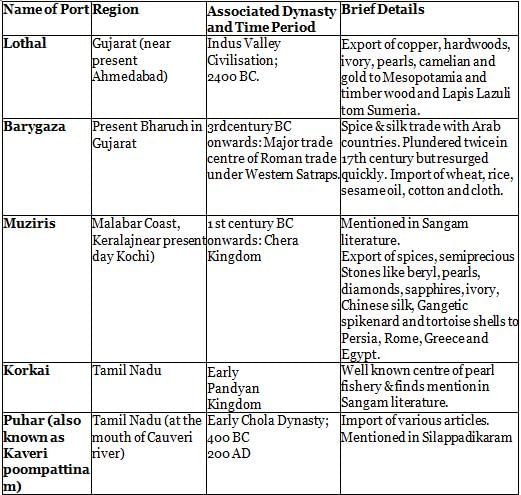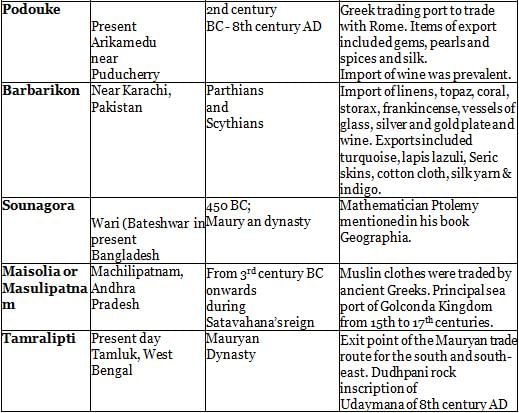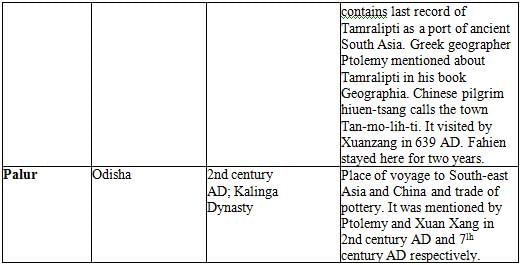INDIA CULTURE ABROAD
Indian Culture- known as First World Culture.
Who Took Indian Culture Abroad?
(i) Romas (wanderers) went abroad to Turkey & other places via Iran and Iraq. They also went to Europe where they were known as Gypsies.
(ii) Trade activities started with Vietnam, Italy & China → many migrated to these countries carrying legacy of our affluent culture.
(iii) Ashoka sent his son & daughter to Sri Lanka to spread Buddhism.
(iv) 1 st century BC, Indian traders travelled to Indonesia & Cambodia in search of gold.
(v) Kalinga dynasty- established trade relations with Sri Lanka.
(vi) Visits of foreign travellers & monks and missionaries led to cross culture exchange.
Prominent Ancient Ports of India
(i) Naval trade during ancient & medieval times played a great role in spread of Indian cultureabroad.
(ii) Detailed account of ports in ancient India can be found from books Periplus of the Erythraean Sea and Geographia. During Mauryan rule, Navadyaksha, i.e.. Superintendent of Shipping used to look after shipping administration.
(iii) Coins of last Satavahana king Yajna Sri Satakarni contained figure of ships.
(iv) Prominent ports in ancient times:



Mathematica from India to Abroad
(i) India invented Number System.
(ii) Zero- invented by Aryabhatta.
(iii) Value of “Pi” & Pythagoras theorem- Baudhayana
(iv) Algebra, Geometry & Trigonometry went abroad from India.
(v) Indians, in 500 BCE, had devised a system of different symbols for every number from one to nine.
(vi) This notation system was adopted by Arabs who called it numerals.
(vii) Maritime traders took decimal system to Arabia.
(viii) Arabs call mathematics ‘hindisat (pertaining to India).
(ix) Concepts were later adopted by western world from there.
(x) Binary number system- first described by Vedic scholar Pingala, in his book Chandahsastra-earliest known Sanskrit treatise on prosody (the study of poetic metres and verse) in 3rd/2nd century BC.
(xi) Fibonacci numbers- first appeared in Indian mathematics as matrameru mentioned by Pingala.
(xii) Methods for formation of numbers were given by mathematicians Virahanka, Gopala and Hemacandra,much before Italian mathematician Fibonacci introduced fascinating sequence to Western European mathematics.
Indian Science and Technology Abroad
(i) Indian scientist Bhaskaracharya (5th century)- rightly calculated the time taken by earth to orbit sun hundreds of years before the astronomer Smart.
(ii) His calculation was - Time taken by earth to orbit the sun is 365.258756484 days.
(iii) Kanad devised atomic theory centuries before John Dalton was born. He speculated existence of Anu or small indestructible particles, much like an atom.
(iv) Extraction of Zinc from Zinc ore was known to Indians 4000 years before British invention.
(v) First seamless celestial globe- made in Kashmir by Ali Kashmiri ibn Luqrnan in reign of the Emperor Akbar.
(vi) Ancient Indians developed Wootz Steel (Ukku, Hindwani and Seric Iron) used to make famous Damascus swords of yore that could cleave a free-falling silk scarf or a block of wood with same ease.
(vii) Gave world idea of the smallest & largest measuring units of Time. Smallest is 34,000th of a second (krati) & largest is 4.32 Billion years (mahayuga).
(viii) Indians- first to use & invent buttons.
(ix) Ornamental buttons made from seashell- used in Indus Valley Civilisation by 2000 BCE.
(x) Buttons were carved into geometric shapes & had holes pierced into them.
(xi) First iron-cased rockets (1780s) by Tipu Sultan of Mysore to be used against British East India Company.
(xii) Shampoo originated in eastern regions of Mughal Empire where it was used as a head massage, consisting of alkali, natural oils and fragrances. Shampoo is derived from Hindi word champo & dates to 1762.
(xiii) It was first introduced in Britain by a Bengali entrepreneur from Bihar named Sake Dean Mahomed.
(xiv) Sushruta- father of surgery. 2600 years ago, he conducted complicated surgeries like cesareans, cataract, artificial limbs, fractures, urinary stones and even plastic surgery and brain surgery.
(xv) Usage of anesthesia was well known in ancient India.
(xvi) First mention of leprosy is described in Indian medical treatise Sushruta Samhita (6th century BC).→
(xvii) Cataract surgery- first found in ancient India & was was performed with a curved needle.
(xviii) Ayurveda- earliest school of medicine known to humans. It was prevalent even in pre-Vedic period, 5000 BC.
(xix) Charaka- father of medicine consolidated Ayurveda 2500 years ago.
(xx) Foreign travellers studied Ayurveda at premier Universities like Nalanda, Taxila and Kashi.
(xxi) Siddha system- regional variant of Ayurveda, nurtured by local Indian Tamil culture and tradition use of metals, minerals and chemical products is predominant. Alchemy actually has its origin in this system.
(xxii) Branch of Siddha dealing with traumatology & injuries- Varmam.
(xxiii) ‘Karela’ (bitter melon)- ancient literature mentions that it is best remedy for diabetes mellitus.
(xxiv) Kernel of ‘Akhrot’ (walnut) resembles the structure of human brain and ancient Indian herbalists used it as brain tonic.
Influence of Indian Religion Abroad
Hinduism Abroad
(i) Thailand- Brahminical images & Hindu temples constructed in third & 4th century AD.
(ii) Earliest images found from Thailand- of Lord Vishnu.
(iii) Vietnam- Cham people built a large number of Hindu temples & worshipped Shiva, Ganesha, Saraswati, Lakshmi, Parvati and Lokeswara.
(iv) Cambodia- famous kingdoms of Champa (Annam) & Kamhuja (Cambodia) were ruled by Hindu kings of Indian origins. Government was run according to Hindu polity & Brahminical jurisprudence.
(v) Malaysia- evidence of Shaivism found in Kedah & in province of Wellesly.
(vi) Female figurines with trident unearthed.
(vii) Head of a Nandi made of granite stone, a relief of Durga image, Ganesha & Shivalinga- excavated.
(viii) Hinduism- over 1.15 billion adherents worldwide (15-16% of world’s population)- majority living in India & Nepal.
(ix) Along with Christianity (31.5%), Islam (23.2%) & Buddhism (7.1%)- it is one of four major religions of world.
Buddhism Abroad
(i) Head of Vikramashila University- Acharya Ateesha, also called Dipankara Shreejnana.
(ii) He went to Tibet (11th century) & gave a strong foundation to Buddhism in Tibet.
(iii) King Ashoka made great efforts to propagate Buddhism outside India & sent his son Mahendra and daughter Sanghamitra to Sri Lanka to spread message of Buddha.
(iv) First monasteries built in Srilanks- Mahavihara & Abhayagiri.
(v) Dipvamsa & Mahavamsa- well known Sri Lankan Buddhist sources.
(vi) Thonmi Sambhota, Tibetan minister was a student at Nalanda.
(vii) Even Tibetan king became a Buddhist & declared Buddhism as State religion.
(viii) Chinese & Indian scholars travelled through ancient Silk routes to propagate philosophy of Buddhism.
(ix) Buddhism went to Korea through China.
(x) Sundo- first Buddhist Monk who entered Korea, carrying a Buddha image & sutras in AD 352.
(xi) He was followed by Acharya Mallananda in AD 384.
(xii) Buddhist texts- printed by Koreans in six thousand volumes.
(xiii) Japan- Buddhism is State Religion.
(xiv) Myanmar- Pagan was great centre of Buddhist culture from 11th to 13th century.
(xv) Missionaries from India established Theravada Buddhism in Southeast Asia, Mahayana Buddhism in East Asia & Vajrayana Buddhism in Central Asia.
Jainism Abroad
(i) Jain religion- originated more than 2500 years ago in India.
(ii) Records of Strabo (64 BC-23 CE), Greek geographer, describes prevalence of Jainism in India.
(iii) Jain business families settled in East Africa several decades ago and some Jains settled in Great Britain, with a great influx from East Africa during expulsion of all South Asians from Uganda under rule of Idi Amin.
(iv) Kobe, Japan- Jains participate in diamond trade.
(v) Jains- began migrating to North America after changes in immigration law in 1965, (Civil Rights movement).
INDIAN LANGUAGES ABROAD
(i) India (780 languages)- has world’s second highest number of languages, after Papua New Guinea (839).
(ii) Sanskrit- originated from India- mother of all European languages.
(iii) Sanskrit books were translated into Chinese- it was accepted as sacred language in Japan.
(iv) Bengali Language- official language of Bangladesh.
(v) Tamil Language- official language of Sri Lanka & Singapore.
(vi) Myanmar- developed their own Pali language & translated both Buddhist and Hindu scriptures in Pali.
(vii) Tibet- Thonmi Sambhot wrote Sanskrit Grammar, based on grammar written by Panini.
(viii) 9600 Sanskr it books- translated into Tibetan.
(ix) Sri Lanka, Pali became- literary language.
(x) Thailand- Thai kingdoms were given Sanskrit names- Dwaravati, Shrivijay, Sukhodaya and Ayutthiya.
(xi) Names of cities in Thailand like Prachinaburi, Singhaburi- derived from Sanskrit.
(xii) Cambodia- Sanskrit remained their language for administration till 14th century.
(xiii) Malaysia, Brahmi, in its late form, was script of ancient Malaysia.
(xiv) Tablets of Buddhist texts written in a script similar to old Tamil- found at Kedah.
(xv) Sanskrit- source languages for them.
(xvi) Large number of Sanskrit words seen in their language, like- svarga, rasa, guna, dahda, mantri and laksha.
(xvii) Indonesia- Sanskrit hymns arecited at time of puja.
INDIAN TEMPLE ARCHITECTURAL TRADITION ABROAD
(i) Science of Architecture & Civil Construction in Ancient India- Sthapatya-Shastra.
(ii) During reign of Ashoka; Afghanistan, Baluchistan & Seistan were parts of Mauryan empire. Buddhist Stupas- constructed in Mauryan provinces.
(iii) Indian art blended with Greek and Kushana styles & spread into central Asia.
(iv) India’s cultural frontiers extended upto Balkh (Vahalika in Vedic texts) on River Oxus (Akshu) & beyond, and played an important role in shaping art traditions which flourished between the 1 st & 8th centuries in Central Asia.
(v) Gandhara school of art of Afghanistan & Central Asia- derived from Indian art styles.
(vi) Besides Central Asia, whole of Southeast Asia received most its art & architectural traditions from India.
(vii) Indian art & architecture- travelled to countries like Indonesia, Malaysia, Vietnam, Laos, Cambodia, Thailand, Burma as also to China, Korea and Japan.
(viii) Cultural contact with Europe under Manuel 1 of Portugal (reign: 25 October 1495-13 December 1521) resulted in exchange of architectural influences.
(ix) China began to build Indian style cave temples & monastic complexes on a large scale & colossal images were carved on the rocks.
(x) Dunhuang, Yun-kang and Lung-men- most famous cave complexes in the world.
(xi) Indonesia- Indian style temple Prambanan, Island of Java (largest Shiva temple in Indonesia).
(xii) 108-metre-high statue of Buddha at Dong Duong- closely resemblesAmravati sculptures; presence of curly hair especially, indicates Indian origin.
(xiii) Bali islands in Indonesia- many idols of Ganesha are found.
(xiv) Thailand- Ayutthiya (Ayodhya)- large number of temples still stand. 400 Indian style of temples in Bangkok.AD 404- Indian monk built two temples in Pyongyang city in Korea.
(xv) Indian Monasteries and temples- centres of devotion & learning all over Korea.
(xvi) Myanmar- King Aniruddha adopted Indian style of temple architecture & built Shwezegon Pagoda & a thousand other temples.
(xvii) Cambodia- huge monuments & temple of Indian style arc constructed &cmbcllishcd them with sculptural representations of Shiva, Vishnu.
(xviii) Angkor Wat- abode of Vishnu, that is, Vaikunthadhama.
(xix) Grand Indian style temple at Yashodharapura in 11th century, known as Baphuon.
(xx) Malaysia- place called Ligor- over 50 Indian temples are found.
(xxi) Boddhisattvas (huge Buddha Statues) at Bamiyan in Afghanistan-^ carved out of hillside in 1st century under patronage of Kushana emperor Kanishka.
(xxii) Sri Lanka- heavily influenced by Indian art & architecture.
(xxiii) Stupas in Sri Lanka - 3rd century BC to 4th century AD- followed Indian pattern of a hemispherical Stupa shaped like an egg & called Anda.
(xxiv) Indian influences- in Europe Christian Basilicas have similarities with Buddhist Stupas.
(xxv) Indian motifs- traced in Gothic sculpture in carvings in cathedrals of Bayeux, Achen and Trier.
(xxvi) Pervading influence of Indian art & architecture through Buddhism was in South-east Asia.
(xxvii) Dome mosques in all Islamic Countries- derived from Indian style of Stupa.
(xxviii) Hemispherical construction of stupas- influenced Byzantine architecture perhaps through Pre-Islamic, Sassanian Persia.
(xxix) Sophia mosque at Istanbul overlooking Bosphorous Straits has domes resembling Buddhist Stupa.
(xxx) Minarets in mosque were erected when Ottoman Turks captured Istanbul (then called Constantinople) from Byzantine Empire in 15th century.
Global Influence of Indian Epics
(i) Shadow play-Wayung wheremthemes are derived mainly from epics Ramayana & Mahabharata is very popular in South East Asia.
(ii) In Thailand- names of streets like Rajaram, Rajajrani, Mahajaya & Cakravamsha indicate popularity of Ramayana.
(iii) In Cambodia, stories of Ramayana & Krishna are carved on walls of temple,
(iv) References of Malaysia in Ramayana, Jataka stories, Milind Panha, Silappadikaram, Raghuvamsha etc.
(vi) Shiva, Vishnu, Buddha etc, from Indian Epics have great influence upon people of Cambodia.
(vii) Scenes from Ramayana and Mahabharata are engraved on Angkor Wat temple.
(viii) Baphuon temple- scenes from battle between Rama & Ravana, Shiva on mount Kailasha with Parvati & ndestruction of Kamadeva are engraved.
ROLE OF INDIAN UNIVERSITIES AND SCHOLARS
(i) Indian universities- most important centres of cultural interaction.
(ii) World’s first University- Takshila established around 700 BC.
(iii) Nalanda Mahavihara- established in 5th century AD- one of the greatest achievements of India in field of Education. Hiuen Tsang (Indian name Mokshadeva) studied at Nalanda for two years under guidance of Shilabhadra.
(iv) I-Tsing, a Chinese Buddhist traveller stayed at Nalanda for 10 years.
(v) Shantarakshita, who pioneered propagation of Buddhism in Tibet in 8lh century- scholar of Nalanda.
(vi) Other scholars- Aryabhatta, Atisha, Dignaga, Dharmapala &Nagarjuna.
(vii) Vikramashila- another university on right bank of Ganges.
(viii) Another university- Odantapuri in Bihar which grew under patronage of the Pala kings.
(ix) Many monks migrated from this university and settled in Tibet; two Indian teachers- Kashyapa Martanga & Dharmarakshita went to China on an invitation from Chinese Emperor in 67 AD. Their names are
(x) Acharya Kamalasheel - Nalanda University - invited by king of Tibet.
(xi) Tibetan King, Naradeva- sent his minister Thonmi Sambhot accompanied by 16 outstanding scholars to Magadha to study under Indian teachers.
(x) Scholar Bodhidharma- specialised in philosophy of Yoga & venerated in China and Japan.
(xi) Bodhidharma- people began to worship him in China and Japan.
(xii) In Korea, the kings and queens, princes and ministers practiced yoga to be brave and fearless.
(xiii) Indian sages carried yogic science to Asia, Middle East, Northern Africa and South America.
(xiv) Agastya, Saptarishi who travelled across Indian subcontinent, crafted this culture around a core yogic way of life.



Indian Sports and Games Abroad
(i) Chess, snakes & ladder, playing cards, Polo, Judo & Karate- originated in ancient India.
(ii) Snakes and ladders created by 13th century poet saint Gyandev & was originally called ‘Mokshapat’.It was played with cowrie shells & dices. It meant that good deeds take us to heaven and evil to a cycle of re-births.
(iii) Chess- originated in Eastern India in Gupta Empire- early form was called Chaturanga-mentioned in Mahabharata.
(iv) Kho-Kho originated in Maharashtra where it was played on ‘raths’ or chariots, and was known as Rathera → now played in different countries.
(v) India invented card game- Suits. Kridapatram which means ‘painted rags for playing’, is an ancient suits game.






























